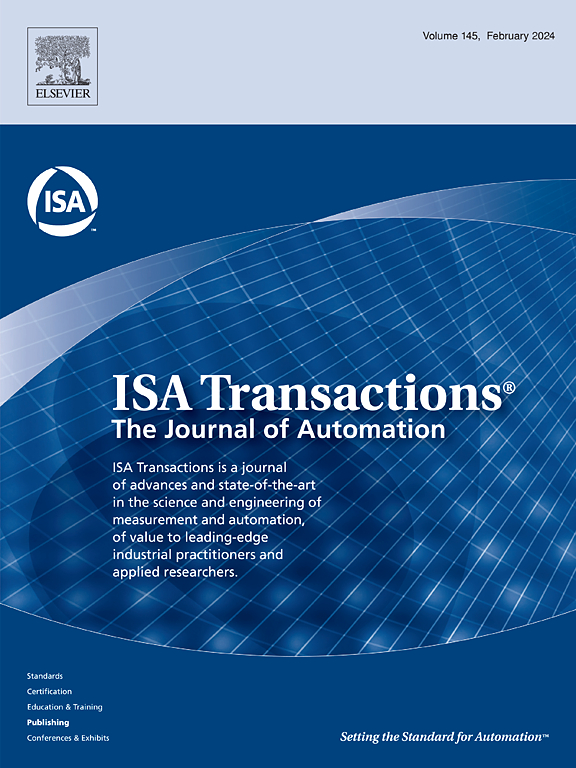Optimal nonlinear PID TSK3DCMAC controller based on balancing composite motion optimization for ballbot with external forces
IF 6.3
2区 计算机科学
Q1 AUTOMATION & CONTROL SYSTEMS
引用次数: 0
Abstract
This paper proposes an innovative approach to address the challenges of dynamic balance and external disturbances in ballbot systems, overcoming the limitations of conventional Proportional Integral Derivative (PID) controllers and their variants in handling highly nonlinear dynamics and external forces. Traditional PID controllers and their variants often have difficulty adapting to complex, real-time dynamic systems, leading to performance degradation under varying conditions. A nonlinear PID controller-based Takagi–Sugeno–Kang 3D Cerebellar Model Articulation Controller (TSK3DCMAC) is introduced to overcome these shortcomings. The proposed controller is developed utilizing a combination of nonlinear PID control, TSK3DCMAC, and the Balancing Composite Motion Optimization (BCMO) algorithm. The TSK3DCMAC is iteratively trained during the ballbot's motion to ensure the system balance in a very steady and seamless manner. Furthermore, the BCMO algorithm is utilized to obtain the optimal gains for precisely modeling the system. The stability of NPID-TSK3DCMAC law is analyzed using the Lyapunov technique. The simulation and experimental results highlight the effectiveness of the NPID-TSK3DCMAC controller. Without external force, it reduces the mean squared error (MSE) by 45.84 % and 99.87 % and the mean absolute error (MAE) by 25.68 % and 63.91 % compared to the PID and NPID controllers, respectively. With external force, it further surpasses the NPID controller by 64.94 % in MSE and 17.67 % in MAE, demonstrating its robustness and precision under varying conditions. Simulation and experiment results reveal that the proposed approach has robustness and effectively regulates the motion of the ballbot system despite external disturbances. This indicates a promising solution for applications requiring precise/agile motion control and stability under varying external conditions.
基于非线性PID TSK3DCMAC的有外力球机器人平衡复合运动优化。
本文提出了一种创新的方法来解决球机器人系统中动态平衡和外部干扰的挑战,克服了传统的比例积分导数(PID)控制器及其变体在处理高度非线性动力学和外力方面的局限性。传统的PID控制器及其变体通常难以适应复杂的实时动态系统,导致其在不同条件下的性能下降。为了克服这些缺点,提出了一种基于非线性PID控制器的三维小脑模型关节控制器(TSK3DCMAC)。该控制器是利用非线性PID控制、TSK3DCMAC和平衡复合运动优化(BCMO)算法的组合开发的。在球机器人运动过程中迭代训练TSK3DCMAC,以确保系统以非常稳定和无缝的方式平衡。利用BCMO算法获得最优增益,实现了系统的精确建模。利用李雅普诺夫技术分析了NPID-TSK3DCMAC律的稳定性。仿真和实验结果验证了NPID-TSK3DCMAC控制器的有效性。在无外力的情况下,与PID和NPID控制器相比,其均方误差(MSE)分别降低了45.84 %和99.87 %,平均绝对误差(MAE)分别降低了25.68 %和63.91 %。在外力作用下,该方法在MSE和MAE上分别比NPID控制器高出64.94 %和17.67 %,证明了其在变条件下的鲁棒性和精度。仿真和实验结果表明,该方法具有鲁棒性,能够有效地调节球机器人系统的运动。这为在不同外部条件下需要精确/敏捷运动控制和稳定性的应用提供了一个有前途的解决方案。
本文章由计算机程序翻译,如有差异,请以英文原文为准。
求助全文
约1分钟内获得全文
求助全文
来源期刊

ISA transactions
工程技术-工程:综合
CiteScore
11.70
自引率
12.30%
发文量
824
审稿时长
4.4 months
期刊介绍:
ISA Transactions serves as a platform for showcasing advancements in measurement and automation, catering to both industrial practitioners and applied researchers. It covers a wide array of topics within measurement, including sensors, signal processing, data analysis, and fault detection, supported by techniques such as artificial intelligence and communication systems. Automation topics encompass control strategies, modelling, system reliability, and maintenance, alongside optimization and human-machine interaction. The journal targets research and development professionals in control systems, process instrumentation, and automation from academia and industry.
 求助内容:
求助内容: 应助结果提醒方式:
应助结果提醒方式:


